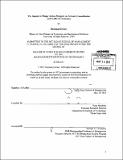The impacts of major airline mergers on network consolidation and traffic performance
Author(s)
Greiser, Henning
DownloadFull printable version (26.60Mb)
Other Contributors
Sloan School of Management.
Advisor
Peter Belobaba.
Terms of use
Metadata
Show full item recordAbstract
In response to the many challenges faced by US airlines in the past decade, merger activity has increased significantly. By combining their networks, airlines commonly aim to not only realize cost synergies but also achieve revenue synergies as well through increased network coverage. In practical terms, this means that the combined airline can cut its total capacity without reducing traffic as it benefits from a larger network and more connecting options via its hubs. The objective of this thesis is to find evidence to confirm this effect based on recent merger activity by comparing both capacity and traffic data before and after the integration period. Particular emphasis is placed on the changing role of hubs to highlight capacity and traffic shifts in a combined network. Two of the most recent major mergers, Delta-Northwest and United-Continental, exhibit how the networks of previously independent carriers were consolidated to achieve the above-mentioned synergies. Delta concentrated capacity at its largest hub in Atlanta and a small number of additional hubs while other hubs experienced a significant downsizing. Additionally, the airline also eliminated a large number of point-to-point services that were bypassing the hubs in order to maximize the use of its hubs. United and Continental, on the other hand, engaged in fairly minor capacity redistribution instead of sweeping reductions. Both carriers increased the share of capacity operated by regional partners and grew capacity between most of the hubs as well. Over the same time frame, however, both of the combined airlines lost passengers compared to their pre-merger levels. While exogenous factors like the recent recession and operational issues played a role, network strategies at both airlines also affected traffic. Delta was unable to recover most of the passengers it lost on the eliminated point-to-point services. For United, the shift towards more international capacity indicates a displacement of domestic traffic by international connecting passengers. Although both carriers had not returned to their pre-merger traffic levels by the end of the integration period, Delta's 2012 performance suggests that network integration and consolidation can have positive effects in the long run.
Description
Thesis (S.M. in Management Studies)--Massachusetts Institute of Technology, Sloan School of Management, 2013. Cataloged from PDF version of thesis. Includes bibliographical references (p. 114-116).
Date issued
2013Department
Sloan School of ManagementPublisher
Massachusetts Institute of Technology
Keywords
Sloan School of Management.